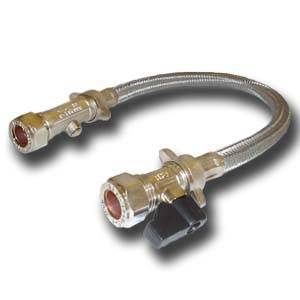Checking Water Levels
Make sure we have water in the system
Depending on the type of boiler you have, you will either have tanks in the loft, or a gauge/digital readout on the boiler informing you of how much water is in the system. Without water in the system, your boiler will probably overheat, underperform, and most likely lead to premature failure of components due to in effect boiling dry. So, what can we do?
- check ball valve's in tanks regularly to make sure they are not seized, operate arm up and down to make sure water is coming out and then shutting off correctly
- check water level in tanks in loft to make sure there is some water present,
- ensure the tanks are not full of debris and gunge, this can get into feed pipes and cause blockages
- for combi boilers and sealed systems, check your pressure gauge for correct water level reading, this is normally between 1 to 1.5 bar when cold
Check your pressure gauge
Pressure gauge as found on combi boilers and 'sealed' systems |
Here we can see a pressure gauge found on modern combi boilers and sealed systems. The black finger indicates how much pressure is in the system and boiler, and clearly this boiler is empty, on zero. We would probably have a groaning and noisy boiler in this state, or it may even have a low pressure cut out to prevent use until the pressure has been topped up again. The red finger is normally a guide as to where to set the pressure, or can be used a a warning to tell us visually when the needle has got to a certain place.
Find your filling loop, or filling tap
So, the pressure's on 0, (or zero), and we want to put some water pressure in, how do we do it? We need to find the filling loop, or filling tap assembly. It will hopefully be assembled such as this one on the left, if not, we need to hand tighten the flexible silver hose onto the taps (there may be caps we need to remove from the taps first). Then, we open the tap/s, which are the black handles. The tap is shown as being open in this picture. When they are at a right angle to the pipe, they are off. You may only have one black tap to turn, you maye have two, or you may even have a screwdriver slot.
At this point, the needle, or display on the boiler will start to rise, and we are aiming for roughly 1 bar of pressure if the system is cold, and 1.5 bar if the system is warm. Don't worry if we put too much in, the boiler should have an inbult safety mechanism to discharge the excess water in the event of putting too much in. However, try and get it right first time, as the safety mechanism can keep on dripping once it's started, and then you'll keep having to top up the pressure!
Correct setting pressure
Correct Setting Pressure |
|---|
Here we can see a pressure gauge with a useful indication of where the pressure should actually be set at. This system has been running for a little while, hence the slight rise in pressure. But as you can see, the green portion is 1 bar pressure, and we are at just under 1.5 bar. Perfect!
Other methods of filling
You may not have a flexible filling loop, some modern boilers have a rigid filling loop, or a filling key, as used on Worcester Bosch Boilers. Please consult your users instructions for more information, as there are several methods employed by different brands.

